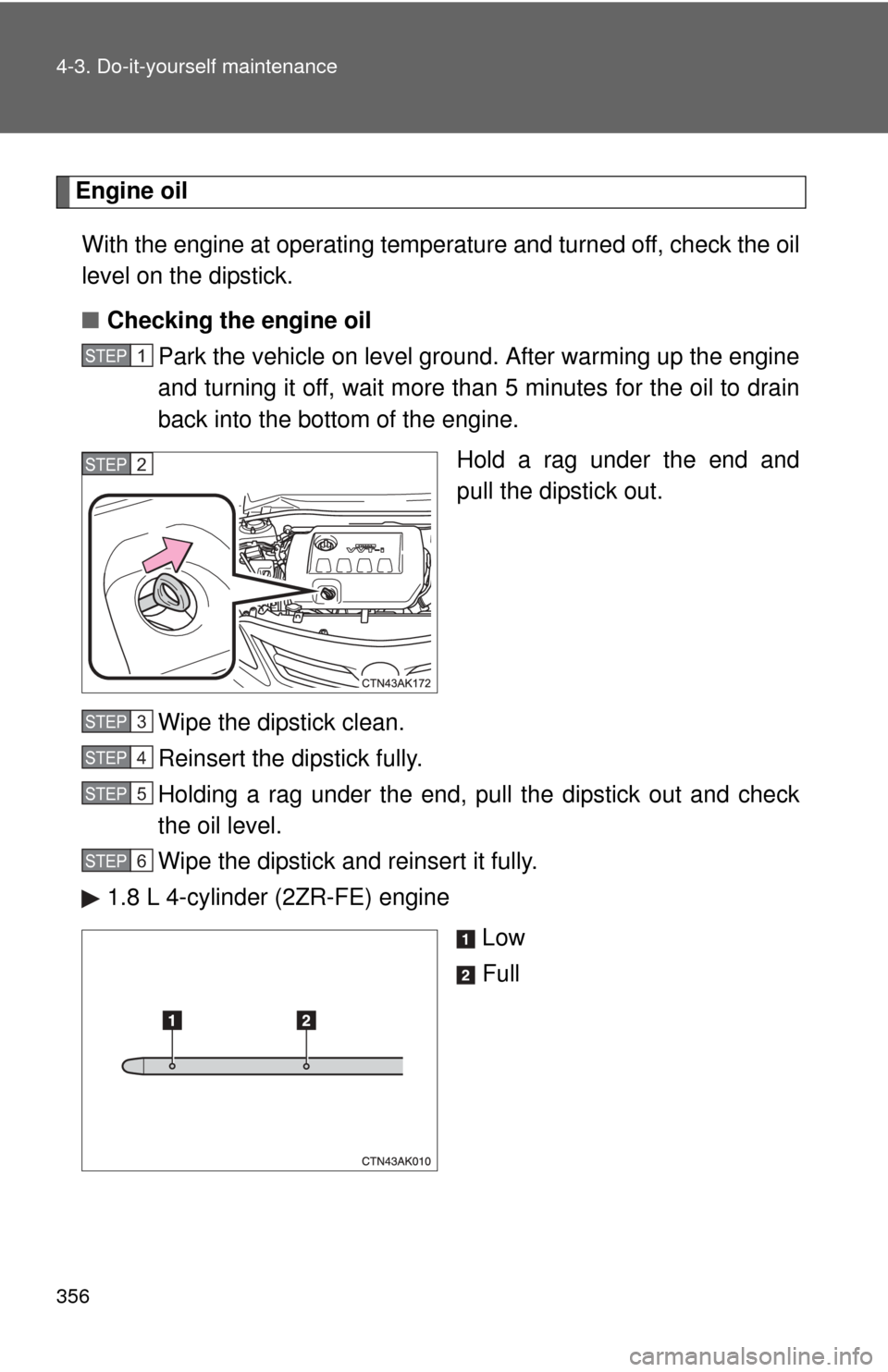2012 TOYOTA COROLLA oil temperature
[x] Cancel search: oil temperaturePage 347 of 529

347
4-3. Do-it-yourself maintenance
4
Maintenance and care
CAUTION
The engine compartment contains many mechanisms and fluids that may
move suddenly, become hot, or become electrically energized. To avoid death
or serious injury observe the following precautions.
■
When working on the engine compartment
●Keep hands, clothing, and tools away from the moving fan and engine
drive belt.
● Be careful not to touch the engine, radiator, exhaust manifold, etc. right
after driving as they may be hot. Oil and other fluids may also be hot.
● Do not leave anything that may burn easily, such as paper or rags, in the
engine compartment.
● Do not smoke, cause sparks or expose an open flame to fuel or the bat-
tery. Fuel and battery fumes are flammable.
● Be extremely cautious when working on the battery. It contains poisonous
and corrosive sulfuric acid.
● Take care because brake fluid can harm your hands or eyes and damage
painted surfaces.
If fluid gets on your hands or in your eyes, flush the affected area with
clean water immediately.
If you still experience discomfort, see a doctor.
■ When working near the electric c ooling fans or radiator grille
Vehicles with smart key system: Be sure the “ENGINE START STOP” switch
is OFF. With the “ENGINE START STOP” switch in IGNITION ON mode, the
electric cooling fans may automatically start to run if the air conditioning is on
and/or the coolant temperature is high. ( P. 361)
Vehicles without smart key system: Be sure the engine switch is OFF. With
the engine switch in the “ON” position, the electric cooling fans may auto-
matically start to run if the air conditioning is on and/or the coolant tempera-
ture is high. ( P. 361)
■ Safety glasses
Wear safety glasses to prevent flying or falling material, fluid spray, etc. from
getting in the eyes.
Page 356 of 529

356 4-3. Do-it-yourself maintenance
Engine oilWith the engine at operating temperature and turned off, check the oil
level on the dipstick.
■ Checking the engine oil
Park the vehicle on level ground. After warming up the engine
and turning it off, wait more than 5 minutes for the oil to drain
back into the bottom of the engine.
Hold a rag under the end and
pull the dipstick out.
Wipe the dipstick clean.
Reinsert the dipstick fully.
Holding a rag under the end, pull the dipstick out and check
the oil level.
Wipe the dipstick and reinsert it fully.
1.8 L 4-cylinder (2ZR-FE) engine
Low
Full
STEP 1
STEP 2
STEP 3
STEP 4
STEP 5
STEP 6
Page 469 of 529

469
6-1. Specifications
6
Vehicle specifications
■
Engine oil selection
“Toyota Genuine Motor Oil” is used in your Toyota vehicle. Use
Toyota approved “Toyota Genuine Motor Oil” or equivalent to satisfy
the following grade and viscosity.
Oil grade: ILSAC multigrade engine oil
Recommended viscosity:
1.8 L 4-cylinder (2ZR-FE) engine
SAE 0W-20
SAE 0W-20 is the best choice for
good fuel economy and good
starting in cold weather.
If SAE 0W-20 is not available,
SAE 5W-20 oil may be used.
However, it must be replaced
with SAE 0W-20 at the next oil
change.
Oil viscosity (0W-20 is explained here as an example):
• The 0W in 0W-20 indicates the characteristic of the oil which allowscold startability. Oils with a lower value before the W allow for easier
starting of the engine in cold weather.
• The 20 in 0W-20 indicates the viscosity characteristic of the oil when the oil is at high temperature. An oil with a higher viscosity (one with a
higher value) may be better suited if the vehicle is operated at high
speeds, or under extreme load conditions.
Outside temperature
Page 470 of 529

470 6-1. Specifications
2.4 L 4-cylinder (2AZ-FE) engine
SAE 5W-20 or SAE 0W-20SAE 5W-20 or 0W-20 engine oil
may be used. However, SAE
0W-20 is the best choice for
good fuel economy and good
starting in cold weather.
Oil viscosity (0W-20 is explained here as an example):
• The 0W in 0W-20 indicates the characteristic of the oil which allowscold startability. Oils with a lower value before the W allow for easier
starting of the engine in cold weather.
• The 20 in 0W-20 indicates the viscosity characteristic of the oil when the oil is at high temperature. An oil with a higher viscosity (one with a
higher value) may be better suited if the vehicle is operated at high
speeds, or under extreme load conditions.
How to read oil container label:
The ILSAC (International Lubricant Standardization and Approval
Committee) Certification Mark is added to some oil containers to help
you select the oil you should use.
Outside temperature
Page 485 of 529

485
6-1. Specifications
6
Vehicle specifications
Warning: The temperature grades for this tire are established for a
tire that is properly inflated and not overloaded.
Excessive speed, underinflation, or
excessive loading, either sepa-
rately or in combination, can caus e heat buildup and possible tire fail-
ure.
Glossary of tire terminology
Tire related termMeaning
Cold tire inflation pres-
sure Tire pressure when the vehicle has been
parked for three hours or more, or has not
been driven more than 1 mile or 1.5 km under
that condition
Maximum inflation
pressure The maximum cold inflated
pressure to which a
tire may be inflated, s hown on the sidewall of
the tire
Recommended infla-
tion pressure Cold tire inflation pressure recommended by a
manufacturer
Accessory weight The combined weight (in excess of those stan-
dard items which may be replaced) of auto-
matic transmission, power steering, power
brakes, power windows, power seats, radio
and heater, to the extent that these items are
available as factory-installed equipment
(whether installed or not)
Curb weight The weight of a motor vehicle with standard
equipment, including the maximum capacity of
fuel, oil and coolant, and if so equipped, air
conditioning and additional weight optional
engine
Maximum loaded vehi-
cle weight The sum of:
(a) Curb weight
(b) Accessory weight
(c) Vehicle capacity weight
(d) Production options weight
Page 517 of 529

517
Alphabetical index
Electric power steering........... 173
Electronic key
If your electronic key battery is discharged .......... 448
Emergency flashers
Switch ................................... 412
Emergency, in case of If a warning light turns on ..... 420
If the electronic key does
not operate properly ........... 448
If the engine will not start...... 444
If the shift lever cannot be
shifted from P ..................... 446
If the vehicle has a
discharged battery ............. 450
If the warning buzzer sounds ............................... 420
If you have a flat tire ............ 432
If you lose your keys............. 447
If you think something is wrong ................................. 418
If your vehicle becomes stuck................................... 459
If your vehicle has to be stopped in an emergency... 461
If your vehicle needs to be
towed ................................. 413
If your vehicle overheats ...... 456 Engine
Compartment ........................354
Engine switch ................131, 135
Hood......................................349
How to start the
engine .........................131, 135
Identification number .............464
If the engine will not start ......444
Ignition switch................131, 135
Overheating...........................456
Engine coolant
Capacity ................................471
Checking ...............................360
Preparing and checking before winter .......................181
Engine coolan t temperature
gauge ......................................149
Engine immobilizer system.......81
Engine oil Capacity ................................468
Checking ...............................356
Preparing and checking before winter .......................181
Engine switch light ..................307
EPS ............................................173
Event data recorder ...................17E
Page 520 of 529

520 Alphabetical index
Noise from under vehicle ..........15
Odometer .................................. 149
OilEngine oil .............................. 356
Opener Fuel filler door .........................77
Hood...................................... 349
Trunk .......................................47
Outside rear view mirrors
Adjusting and folding ...............69
Outside temperature display .................................... 156
Overheating, Engine ................456
Parking brake ........................... 147
Parking lights Replacing light bulbs ............. 399
Switch.................................... 160
Wattage ................................. 475
Personal lights
Switch.................................... 309
Wattage ................................. 475
Personal/interior lights
Switch.................................... 310
Wattage ................................. 475
Power outlet ............................. 325
Power windows ..........................71 Radiator .................................... 361
Radio ......................................... 232
Rear seats
Folding down........................... 54
Rear side marker lights
Replacing light bulb............... 399
Switch ................................... 160
Wattage................................. 475
Rear turn signal lights Replacing light bulbs ............. 399
Switch ................................... 146
Wattage................................. 475
Rear view mirror Compass ............................... 329
Rear window defogger ............ 219
Replacing Fuses .................................... 389
Key battery ............................ 385
Light bulbs............................. 399
Tires ...................................... 432
Reporting safety defects for U.S.A. owners ........................ 498
Reset the maintenance
data ......................................... 340N
O
P
R